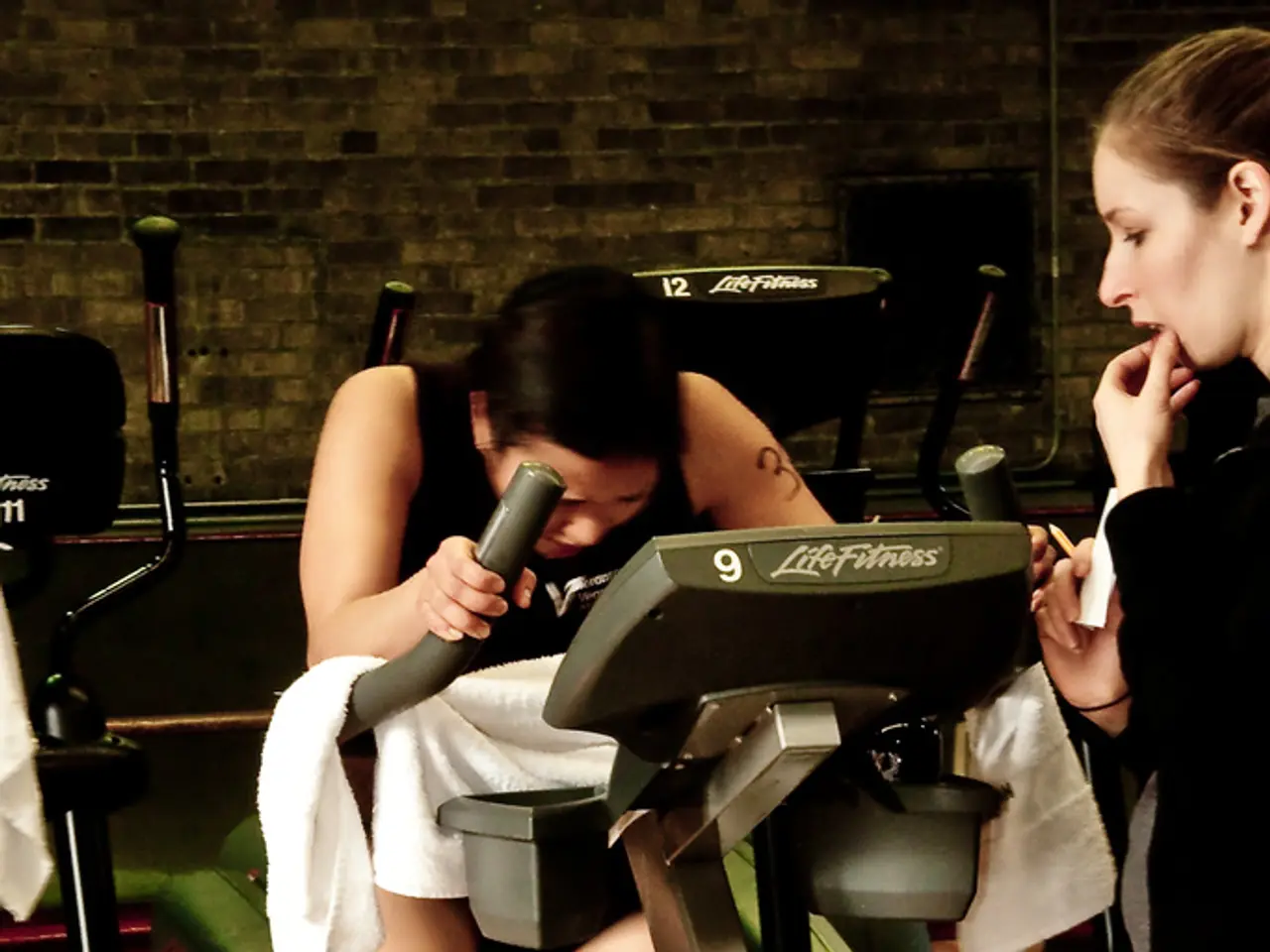Workout Sessions: Guidelines, Advantages, and Beyond
In a world where stress levels and menstrual discomfort often go hand in hand, a 2018 study offers a promising solution: regular exercise. It suggests that committing to a 30-minute workout, three days a week, for eight weeks, can significantly reduce menstrual pain [1]. This article explores the benefits, tips, and precautions of exercising during menstruation.
### The Benefits of Exercising During Menstruation
Exercise stimulates the release of endorphins, the body's natural mood enhancers and pain relievers [2][3][4]. This can help alleviate menstrual pain, irritability, and stress levels during periods. In addition, aerobic activities like walking, cycling, or dancing increase blood flow and reduce hormone levels that cause water retention, thus helping to combat cramps and bloating [1][3].
Moderate exercise also promotes muscle relaxation and may improve sleep quality, which often suffers during menstruation due to hormonal fluctuations [1]. Furthermore, gentle movement helps counteract common PMS symptoms like fatigue and pelvic discomfort by improving circulation [3].
### Tips for Exercising During Your Period
To ensure comfort and safety, it's essential to choose low-to-moderate intensity workouts such as yoga, Pilates, walking, or light aerobic exercises [2][3][4]. It's also crucial to listen to your body and adjust or stop exercising if you experience pain, dizziness, or excessive discomfort [2].
Staying hydrated is another key factor. Drinking plenty of water before, during, and after workouts can prevent dehydration and cramping [2]. Wearing comfortable, breathable clothing is also important, especially moisture-wicking fabrics and well-fitting shoes [2].
Engaging in preferred exercises can make workouts more enjoyable and sustainable during your period [5]. Some people may opt to wear dark pants during exercise to account for potential leaks [6]. Bringing a spare pair of underwear or clothes to the gym can also be helpful after exercise [7].
### Precautions When Exercising on Your Period
While exercise can offer numerous benefits during menstruation, it's important to be aware of potential risks. Avoid high-impact exercises if discomfort is severe, as running or jumping may worsen cramps or pelvic pain [2].
Heavy menstrual flow combined with exercise could increase the risk of anemia [8]. Therefore, it's crucial to monitor your flow and consult healthcare providers if needed, especially if you have pelvic floor concerns, incontinence, or other health conditions [2].
Using appropriate menstrual products designed for a heavier flow can help you feel secure and focused during workouts [5]. Applying ice or a cloth-covered heating pad after exercising can help alleviate back pain and cramping [9].
Overall, it's best to listen to your body during menstruation and reduce the intensity of your exercise routine if you feel very fatigued [10]. Exercising during a person's menstrual period may help reduce symptoms such as mood swings, menstrual cramps, and fatigue [11].
In conclusion, combining gentle exercise tailored to your comfort with these safety measures can help you take advantage of the positive effects exercise offers during menstruation while minimizing risks [1][2][3][4].
References: [1] American College of Obstetricians and Gynecologists. (n.d.). Exercise During Your Period. Retrieved from https://www.acog.org/womens-health/faqs/exercise-during-your-period [2] American College of Sports Medicine. (2018). ACSM's Guidelines for Exercise Testing and Prescription. Lippincott Williams & Wilkins. [3] Nieman, D. C., & Wentz, L. M. (2011). Exercise and Mood: From Antidepressant to Antianxiety and Beyond. Sports Medicine, 41(7), 533-558. [4] Pritchett, K. E., & Hackney, A. C. (2010). Exercise and Menstrual Cycle Dysfunction. Sports Medicine, 40(4), 327-343. [5] Yoga Journal. (2016). Yoga for Menstruation. Retrieved from https://www.yogajournal.com/practice/yoga-for-menstruation [6] WebMD. (2020). Exercise and Your Period: What You Need to Know. Retrieved from https://www.webmd.com/women/features/exercise-period [7] Women's Health. (2018). How to Exercise During Your Period. Retrieved from https://www.womenshealthmag.com/fitness/a20473395/exercise-during-your-period/ [8] Mayo Clinic. (2020). Iron-Deficiency Anemia. Retrieved from https://www.mayoclinic.org/diseases-conditions/iron-deficiency-anemia/symptoms-causes/syc-20373732 [9] Healthline. (2019). 11 Natural Ways to Relieve Menstrual Cramps. Retrieved from https://www.healthline.com/health/menstrual-cramps/natural-ways-to-relieve-menstrual-cramps [10] Healthline. (2019). 7 Ways to Boost Your Energy During Your Period. Retrieved from https://www.healthline.com/health/menstrual-cycle/7-ways-to-boost-your-energy-during-your-period [11] Harvard Health Publishing. (2018). Exercise and Your Menstrual Cycle. Retrieved from https://www.health.harvard.edu/staying-healthy/exercise-and-your-menstrual-cycle
- Menstrual pain, irritability, and stress levels during periods can be alleviated through exercise, as it stimulates the release of endorphins, the body's natural mood enhancers and pain relievers.
- Aerobic activities like walking, cycling, or dancing, when performed regularly, can reduce menstrual pain, combat cramps, and bloating by increasing blood flow and decreasing hormone levels that cause water retention.
- Moderate exercise promotes muscle relaxation, improves sleep quality, and helps counteract common PMS symptoms like fatigue and pelvic discomfort by improving circulation.
- To ensure comfort and safety during exercising during menstruation, it's recommended to choose low-to-moderate intensity workouts like yoga, Pilates, walking, or light aerobic exercises and to stay hydrated by drinking plenty of water.
- Wearing comfortable, breathable clothing, especially moisture-wicking fabrics and well-fitting shoes, is important, and some people may opt to wear dark pants during exercise to account for potential leaks.
- While exercise offers numerous benefits during menstruation, it's important to be aware of potential risks such as heavy menstrual flow increasing the risk of anemia, and severe discomfort may worsen cramps or pelvic pain, so it's crucial to adjust or stop exercising if needed.




